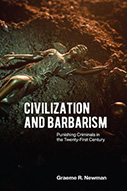Civilization And Barbarism: Punishing Criminals In The Twenty-First Century

Author: Graeme R. Newman
Publisher: Albany: SUNY Press, 2020. 272 p.
Reviewer: David Schultz | May 2021
“The punishment should fit the crime “is the exclamation of perhaps the most famous song of the musical The Mikado. But the task has always been to decide what type of punishment for what type of crime. Graeme Newman’s polemic in rethinking punishment takes an unexpected turn, arguing for a return to a form of corporal punishment–more specifically electric shocks–as a more humane and effective way to make individuals pay for their crime. This is a book that combines classic utilitarian theory with the realities of the failed criminal justice system to reach this conclusion.
According to the author, punishment is an individualistic, personal, and physical act. Specifically, individuals who felt that they had been wronged would inflict bodily injury to the person who they believed had transgressed their rights. This “eye for an eye” retaliation included a variety of actions that included physical mutilation, such as a loss of a finger or a hand for stealing, all the way up to death. Most early punishments lacked proportionality, with loss of life often the preferred choice.
Yet, the so-called civilizing of punishment brought with it several trends. One, punishment was taken out of the hands of the victim and turned over to the state. Two, physical or corporal punishment was replaced with other means such as fines, probation, and most significantly, incarceration. Three, punishment as simply retaliation was justified in terms of deterrence, with the scale or level of punishment for Jeremy Bentham, or its certainty, Cesare Beccaria, critical to the harm calculus of the crime. If wrongdoers are rational calculators and crime is a product of opportunity costs, the right proportionality of punishment would, it was/is believed, serve as the appropriate deterrence.
Collectively these three innovations, but especially incarceration, were viewed as humane improvements in punishment. Corporal punishment or the infliction of pain was simply seen as barbaric. Hence, regardless of how heinous the murder, better life in prison than execution. Globally, this evolution of punishment came to be accepted as part of human rights law and to be seen as a mark of a maturing and more humane criminal justice system.
Yet while prisons were advocated as a human solution to punishment, they have not in fact turned out to be so. As Newman describes in his introduction and the first two chapters, prisons have become a new barbarism. Witness prison overcrowding, sexual assaults, being breeding grounds for drugs abuse, compounding mental illness and other individual pathologies — incarceration has failed. There is little evidence that prisons rehabilitate or deter, and it is even questionable that their use to incapacitate has been successful. Prisons have failed, and it is time to look for a different strategy.
While one could perhaps argue for more in terms of fines, probation, or other methods of punishment, Newman returns to physical punishment as perhaps the new humane way to make wrongdoers pay. For him: “Moderate corporal punishment, as defined in this book, when used carefully and properly,” is not torture (36), but instead its “sole purpose is to inflict pain efficiently, quickly, and temporarily” (36). The bulk of the book presents the case for the use of controlled corporal punishment, including developing — almost along the lines of what Jeremy Bentham did in The Principles of Morals and Legislation — appropriate measures and calculations for punishment.
Newman details what he calls a standard punishment unit (SPU). He argues that such a unit could be used to convert from simply time incarcerated, into a measure of the appropriate amount, timing, and frequency of moderate shocks or corporal punishment (173). For example, he suggests that maybe a five-year prison sentence could be translated into a fixed set of sessions of physical punishment. Punishment, in addition, should be thought of as a commodity. Let individuals buy offender insurance, hire surrogates, or share the punishment with those willing to be compensated for someone else’s bad behavior (175). Moreover, physical punishment could provide a less expensive alternative to incapacitation that would not need prison walls. Why not induced comas as punishment that takes place at home, subject to public inspection, or other forms of repeated moderate doses of pain to incapacitate? Finally, to avoid mistakes or miscalculations, why not have the punishment administered by a robot, or even let the offender self-punish (182)?
The book concludes with two appendices. One responds to criticisms that what the author is advocating is a violation of the US Constitution; that it is fascist; or, that it is devoid of mercy and compassion. Newman rejects all these claims as misguided. The other appendix simply provides a chronology of physical punishment over time.
This is a strange book if taken at face value. If the purpose of the book is to highlight the problems currently with punishment and prisons, then one might read this argument as a form of satire. But the author is serious in his advocacy for a return of measured corporal punishment. While the author is quick to reject arguments that his theory is barbaric, there is no question that there is an emerging consensus that his approach is simply morally retrograde. Newman advocates an Orwellian dystopian solution to a problem of prisons that might well be worse than what he wants to replace. He relies on theories of human psychology that are questionable, and advocates for approaches that could allow for an even greater disparity in punishment that would actually exacerbate the racial and class problems that already exist.


